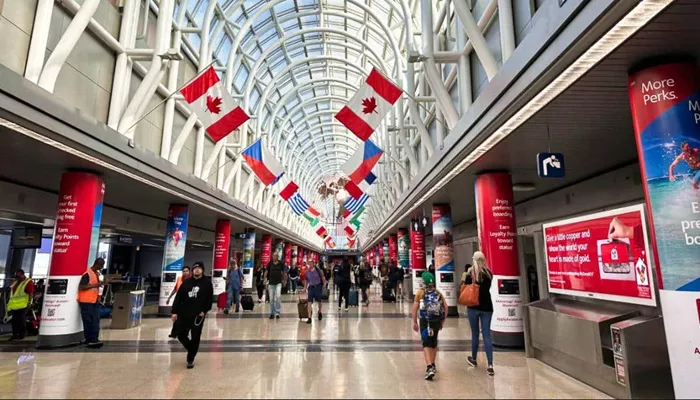Chicago is one of the busiest cities in the United States, and it’s home to two major airports: O’Hare International Airport (ORD) and Midway International Airport (MDW). These airports serve millions of travelers every year, both domestically and internationally. Understanding the Chicago airport codes is essential for anyone planning to travel to or from the city. In this article, we’ll explore the airport codes in detail, how they work, and why they are important for travelers.
What Is an Airport Code?
Airport codes are a set of three-letter abbreviations used to identify airports around the world. These codes are standardized by the International Air Transport Association (IATA). They help simplify travel logistics by providing a unique identifier for each airport. These codes are used on flight tickets, luggage tags, and in flight planning systems to ensure accurate identification of the airport.
Chicago’s Major Airports
Chicago boasts two major airports: O’Hare International Airport and Midway International Airport. Each of these airports plays a crucial role in accommodating the city’s vast air travel demands. Let’s look at each airport in detail.
O’Hare International Airport (ORD)
Overview of O’Hare International Airport
O’Hare International Airport, commonly known as ORD, is one of the busiest airports in the world. It is located on the northwestern side of Chicago, about 17 miles from downtown. O’Hare is a major hub for domestic and international flights, with more than 200 gates across its four terminals. In addition to being one of the busiest airports in terms of passenger traffic, O’Hare also has the distinction of handling a high volume of cargo.
Why Is the Code ORD Used?
The code “ORD” may seem odd since it doesn’t directly correspond to the name “O’Hare.” The “ORD” code actually originates from the airport’s original name, Orchard Field, which was the location of the airport before it became known as O’Hare. When the airport was renamed in honor of Edward O’Hare, a WWII hero, the code was retained.
Key Facilities at O’Hare International Airport
O’Hare International Airport is home to a wide range of facilities, from duty-free shops to luxurious lounges. The airport has four terminals—Terminal 1, Terminal 2, Terminal 3, and Terminal 5—each catering to different airlines and flight routes. There is a strong emphasis on international travel at Terminal 5, with customs and immigration services available for travelers arriving from abroad.
O’Hare offers numerous dining options, ranging from fast food to upscale restaurants, along with retail outlets, lounges, and other amenities designed to enhance the passenger experience. Additionally, O’Hare has an extensive transportation network, including car rentals, taxis, shuttles, and access to the Chicago Transit Authority (CTA) Blue Line train.
Midway International Airport (MDW)
Overview of Midway International Airport
Midway International Airport, known by the IATA code MDW, is the second-largest airport serving Chicago. Located about 10 miles from downtown, Midway primarily serves domestic flights and is a hub for low-cost carriers like Southwest Airlines. Although smaller than O’Hare, Midway is still a significant airport, handling millions of passengers each year.
Why Is the Code MDW Used?
The code “MDW” is derived from the location of the airport. It was named after the nearby Midway Plaisance, a park and historic site in Chicago. The airport was originally a small airfield that grew over time, and its code reflects its geographical association with the surrounding area.
Key Facilities at Midway International Airport
Midway is a smaller airport compared to O’Hare, but it offers a range of services for travelers. The airport has one terminal that serves both arriving and departing flights. It includes various retail outlets, food options, and services such as free Wi-Fi. There is also public transportation access to the airport, including the CTA Orange Line train, which connects Midway to downtown Chicago.
The Importance of Airport Codes in Travel
Streamlining Travel Logistics
Airport codes play an important role in ensuring smooth travel experiences. They simplify the booking process by making it easy to identify specific airports. When you book a flight, the airport code is often used in the flight details, which reduces confusion and ensures you arrive at the right location. Luggage tags also use airport codes to ensure your bags are routed to the correct destination.
Enhancing Safety and Efficiency
Airport codes help in maintaining safety and efficiency at airports. They allow air traffic controllers, pilots, and airline staff to communicate quickly and accurately about locations, routes, and gates. The use of standardized codes also reduces the risk of errors, which is critical for both air travel safety and operational efficiency.
Airport Codes and International Travel
For international travel, airport codes become even more important. Since airports around the world have unique codes, they help airlines and travelers navigate complex global flight routes. This is particularly helpful when flights are connecting between different airports in different countries. Airport codes like ORD and MDW ensure that international flights to and from Chicago are properly coordinated.
How to Find the Airport Code for a Specific Airport
If you need to find the airport code for any airport, including Chicago’s, there are several ways to do so. Many travel websites and booking platforms will automatically display the airport code when you search for a flight. Additionally, you can look up the code on the IATA website or use various mobile apps that track flights and airports.
Conclusion
Understanding Chicago airport codes—ORD for O’Hare International Airport and MDW for Midway International Airport—is important for anyone traveling to or from the city. These codes simplify travel logistics, enhance safety, and streamline flight operations. Whether you’re flying domestically or internationally, knowing the airport codes will ensure that your journey goes smoothly.
By familiarizing yourself with these codes, you can make the travel process more efficient, minimize confusion, and enjoy a hassle-free experience at the airport. As you plan your next trip to Chicago, remember the significance of these codes and how they play a crucial role in modern air travel.

